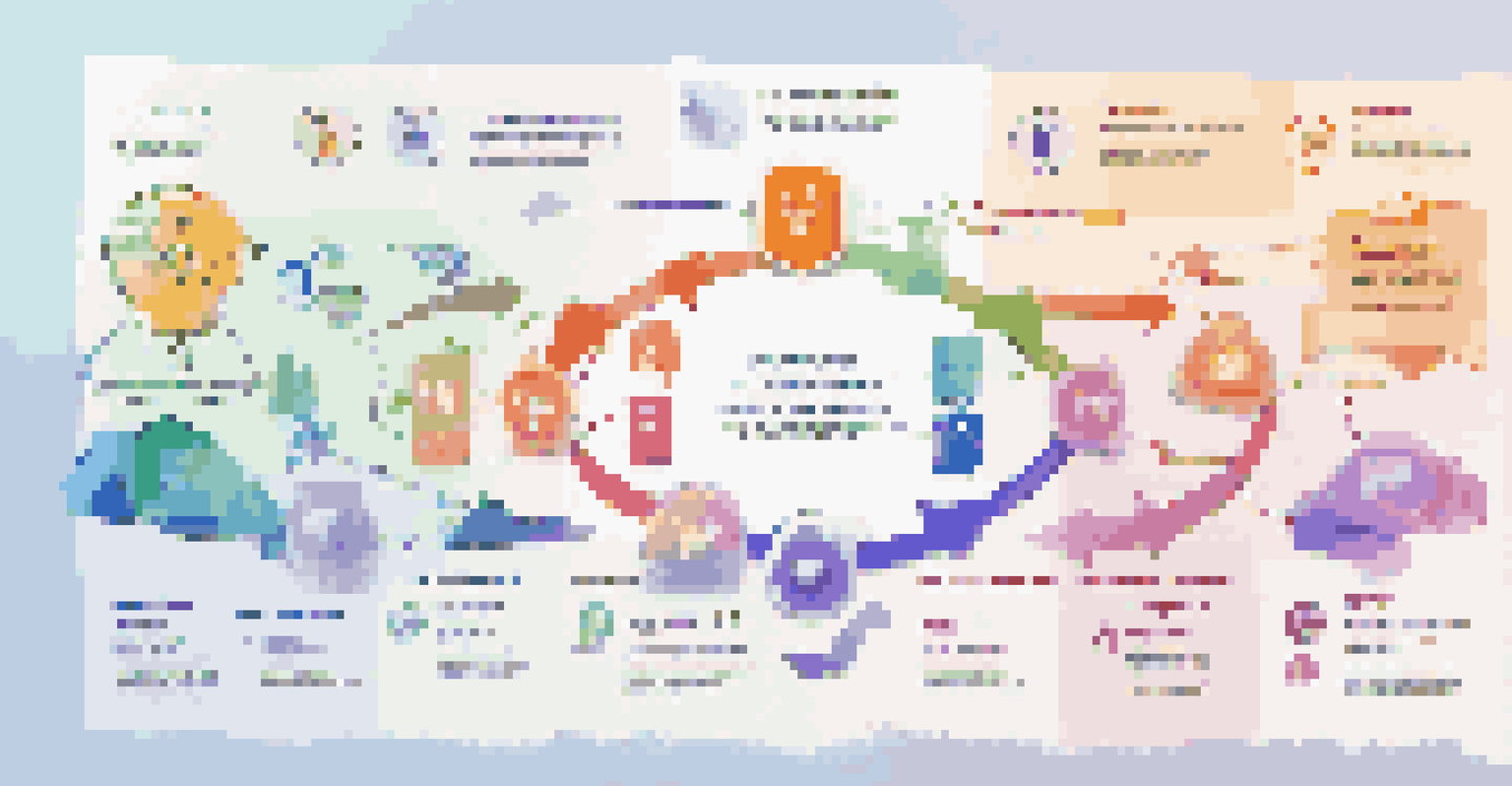Knowledge Management in Remote Work Environments: Best Practices

Understanding Knowledge Management in Remote Work
Knowledge management (KM) is all about capturing, distributing, and effectively using knowledge. In a remote work environment, where team members are often spread across different locations, effective KM becomes crucial. It helps ensure that valuable information is not lost and that everyone has access to the resources they need to perform their jobs efficiently.
Knowledge management is not just about information, it's about creating a culture of sharing and collaboration.
When employees work remotely, they may feel disconnected from the larger team and organizational knowledge. This disconnection can lead to information silos, where vital insights and expertise are not shared. By implementing robust KM practices, organizations can bridge these gaps and foster a culture of collaboration and continuous learning.
Ultimately, effective knowledge management in remote settings empowers employees, enhances productivity, and drives innovation. It’s not just about storing information; it’s about creating an environment where knowledge is easily accessible and actively utilized.
Creating a Centralized Knowledge Repository
One of the first steps in effective KM for remote teams is creating a centralized knowledge repository. This can be a digital space, such as a shared drive or a dedicated platform, where all team members can access essential documents, guides, and resources. Think of it as a 'one-stop shop' for all things related to your organization’s knowledge.

A centralized repository not only simplifies access to information but also encourages contributions from team members. When everyone knows where to go for information, it reduces time spent searching for documents and minimizes redundancy. Plus, it fosters a sense of ownership and accountability among team members as they contribute their own insights and expertise.
Centralized Knowledge Repositories
Creating a centralized knowledge repository simplifies access to essential documents, fostering collaboration and ownership among remote team members.
To make this repository truly effective, it should be organized in a user-friendly manner, with clear categories and search functionalities. Regular updates and maintenance are vital to keep the content relevant and useful, ensuring that knowledge remains fresh and easily accessible.
Encouraging Collaborative Knowledge Sharing
Collaboration is key in any remote work setup, and fostering a culture of knowledge sharing can significantly enhance team dynamics. Encourage team members to share their unique insights and experiences through regular meetings, brainstorming sessions, or dedicated channels on collaboration tools. This practice not only enriches the collective knowledge but also strengthens relationships among team members.
The only thing worse than training your employees and having them leave is not training them and having them stay.
For instance, consider implementing a 'knowledge-sharing hour' where team members can present new findings, lessons learned, or innovative ideas. This informal setting allows everyone to contribute and learn from each other, creating a sense of community that can sometimes be missing in remote environments.
Additionally, leveraging technology like wikis or forums can facilitate ongoing discussions and knowledge exchange. By making knowledge sharing a regular practice, organizations can cultivate an environment where learning from one another becomes the norm, driving both individual and team growth.
Utilizing Technology for Knowledge Management
In today’s digital age, technology plays a pivotal role in knowledge management, especially for remote teams. There are numerous tools available that can help streamline the KM process, from document management systems to project management software. Choosing the right tools can make knowledge sharing more efficient and engaging for your team.
For example, platforms like Microsoft Teams or Slack can facilitate real-time communication and file sharing, while tools like Confluence or SharePoint can serve as robust knowledge repositories. By leveraging these technologies, teams can ensure that important information is easily accessible and that collaboration is seamless, no matter where team members are located.
Fostering Knowledge Sharing Culture
Encouraging regular knowledge sharing through collaborative practices enhances team dynamics and promotes continuous learning.
Moreover, integrating knowledge management tools with existing workflows can enhance productivity. When team members have access to information in the tools they already use, it reduces friction and allows them to focus on their core tasks, resulting in better overall outcomes.
Documenting Processes and Best Practices
Another critical aspect of knowledge management is the documentation of processes and best practices. When team members develop effective methods or discover new solutions, it’s essential to capture that knowledge in a way that others can benefit from it. Documenting these practices not only preserves valuable insights but also serves as a training resource for new employees.
Consider creating detailed guides or instructional videos that outline step-by-step processes. This not only helps maintain consistency across the team but also allows remote workers to onboard more smoothly. The easier it is for new hires to access this information, the quicker they can become productive members of the team.
Encouraging team members to contribute to these documents can also foster a sense of pride and responsibility. When everyone has a role in shaping the knowledge base, it enhances engagement and commitment to sharing valuable insights.
Regularly Reviewing and Updating Knowledge Resources
Knowledge management isn’t a one-time effort; it requires ongoing review and updates to stay relevant. As remote work environments evolve, so do the tools, processes, and information that teams rely on. Regularly revisiting your knowledge resources ensures they remain accurate and useful.
Establish a routine where team members review and provide feedback on existing documents and resources. This collaborative approach not only keeps information fresh but also encourages a culture of continuous improvement. If something isn’t working or needs updating, having an open dialogue about it can lead to better solutions.
Continuous Updates and Learning
Regularly reviewing and updating knowledge resources ensures their relevance and effectiveness, driving better performance in remote work environments.
Moreover, consider setting up a schedule for periodic audits of your knowledge repository. This proactive approach helps identify outdated content and ensures that your team has access to the most current and relevant information, ultimately driving better performance.
Fostering a Culture of Continuous Learning
To truly harness the power of knowledge management, organizations must foster a culture of continuous learning. This means encouraging team members to pursue professional development opportunities, share their learnings, and actively seek out new knowledge. A culture that values learning not only benefits individual growth but also enhances overall team performance.
Incorporate regular training sessions, webinars, or even informal lunch-and-learns where team members can expand their skill sets and share insights. This creates an environment where knowledge is not just accessible but actively sought out and valued. It can also lead to innovative ideas and solutions that propel the organization forward.

Moreover, recognizing and rewarding individuals who contribute to the knowledge-sharing culture can further motivate team members. Celebrating achievements in learning and knowledge sharing reinforces the importance of these values and encourages others to follow suit.
Measuring the Impact of Knowledge Management
Finally, it’s essential to measure the impact of your knowledge management efforts. This helps organizations understand what’s working, what isn’t, and where improvements can be made. Key performance indicators (KPIs) can include metrics like employee engagement in knowledge-sharing activities, the usage of knowledge resources, and overall productivity.
By tracking these metrics, teams can identify trends and areas for enhancement. For example, if certain knowledge resources are underutilized, it may indicate a need for better communication about their availability or relevance. This data-driven approach ensures that knowledge management strategies are continuously refined and aligned with team needs.
Additionally, soliciting feedback from team members about the KM processes can provide valuable insights. This collaborative approach not only highlights areas for improvement but also fosters a sense of involvement among team members, reinforcing the importance of knowledge management within the organization.